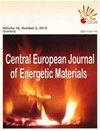Studies on the High Performance Characteristics of an Aluminized Ammonium Perchlorate Composite Solid Propellant Based on Nitrile Butadiene Rubber
IF 0.6
4区 工程技术
Q4 CHEMISTRY, APPLIED
引用次数: 3
Abstract
In the present study, a high performance composite solid propellant formulation was prepared based on nitrile butadiene rubber (NBR) and dibutyl phthalate (DBP) plasticizer, which has a longer pot life and high density specific impulse. The developed cost effective novel binder system was prepared with readily available raw materials (NBR and DBP). The formulation of the composition was performed by varying the content of the NBR/DBP binder in the range of 14-20%. The rocket performance characteristics were determined theoretically using PROPEP and compared with those of an HTPB based propellant. The rheological, mechanical, physical, ballistic and thermal properties of the NBR/ DBP propellant were studied and compared with literature data for similar compositions based on an HTPB/dioctyl adipate (DOA) binder. The yield stress was determined by spreadibilty measurements, and indicated the superiority of this binder based propellant over existing composite propellants. It was concluded that following decreasing the content of the NBR/DBP binder in the propellant from 20 to 14%: Central European Journal of Energetic Materials ISSN 1733-7178; e-ISSN 2353-1843 Copyright © 2021 Łukasiewicz Research Network – Institute of Industrial Organic Chemistry, Poland 493 Studies on the High Performance Characteristics of an Aluminized Ammonium... Copyright © 2021 Łukasiewicz Research Network – Institute of Industrial Organic Chemistry, Poland – in the range 58.83-78.45 bar (5.883-7.845 MPa), the pressure index increased from 0.159 to 0.371, – at 68.64 bar (6.864 MPa), the burning rate increased from 4.10 to 6.54 mm/s, but the theoretical specific impulse value did not change significantly (258.0-基于丁腈橡胶的含铝高氯酸铵复合固体推进剂的高性能研究
本研究以丁腈橡胶(NBR)和邻苯二甲酸二丁酯(DBP)增塑剂为基础,制备了一种具有较长使用寿命和高密度比冲的高性能复合固体推进剂配方。用现成的原材料(NBR和DBP)制备了所开发的具有成本效益的新型粘合剂体系。通过在14-20%的范围内改变NBR/DBP粘合剂的含量来进行组合物的配制。利用推进剂推进剂从理论上确定了火箭的性能特性,并与HTPB基推进剂的性能特性进行了比较。研究了NBR/DBP推进剂的流变、力学、物理、弹道和热性能,并与基于HTPB/己二酸二辛酯(DOA)粘合剂的类似组合物的文献数据进行了比较。通过铺展性测量确定了屈服应力,并表明这种粘合剂基推进剂优于现有的复合推进剂。得出的结论是,在将推进剂中NBR/DBP粘合剂的含量从20%降低到14%之后:《中欧高能材料杂志》ISSN 1733-7178;e-ISSN 2353-1843版权所有©2021Łukasiewicz研究网络-波兰工业有机化学研究所493含铝铵的高性能特性研究。。。版权所有©2021Łukasiewicz研究网络-波兰工业有机化学研究所-在58.83-78.45巴(5.883-7.845兆帕)范围内,压力指数从0.159增加到0.371,在68.64巴(6.864兆帕)下,燃烧速率从4.10增加到6.54 mm/s,但理论比冲值没有显著变化(258.0-
本文章由计算机程序翻译,如有差异,请以英文原文为准。
求助全文
约1分钟内获得全文
求助全文
来源期刊

Central European Journal of Energetic Materials
CHEMISTRY, APPLIED-ENGINEERING, CHEMICAL
CiteScore
1.80
自引率
25.00%
发文量
0
审稿时长
>12 weeks
期刊介绍:
CEJEM – the newest in Europe scientific journal on energetic materials It provides a forum for scientists interested in the exchange of practical and theoretical knowledge concerning energetic materials: propellants, explosives and pyrotechnics. The journal focuses in particular on the latest results of research on various problems of energetic materials.
Topics:
ignition, combustion and detonation phenomenon;
formulation, synthesis and processing;
analysis and thermal decomposition;
toxicological, environmental and safety aspects of energetic materials production, application, utilization and demilitarization;
molecular orbital calculations;
detonation properties and ballistics;
biotechnology and hazards testing
CEJEM presents original research and interesting reviews. Contributions are from experts in chemistry, physics and engineering from leading research centers in Europe, America and Asia. All submissions are independently refereed by Editorial Board members and by external referees chosen on international basis.
 求助内容:
求助内容: 应助结果提醒方式:
应助结果提醒方式:


